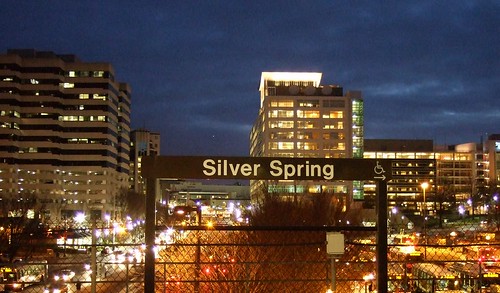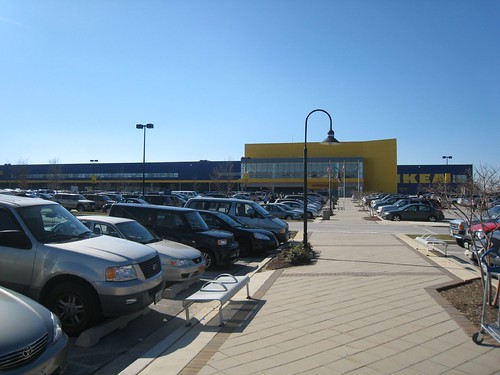Today I stopped in Calverton to fill up on gas. Much to my surprise, the Sunoco station on Cherry Hill Road offered "NBC at the pump", a TV screen with news and entertainment snippets. I had to sort of chuckle at the combination of two uniquely suburban inventions.
I often wonder what of our American toys were popularized or invented because of suburbanization. I've opined in the past that youth sports rose to prominence because of the suburbs. But the popular axiom "it takes a village to raise a child" is virtually lost in isolated, homogenized suburban culture. My mother, who grew up in a Sicilian ghetto in the West Side of Buffalo back when it was a thriving industrial city, used to bemoan the amount of television I watched growing up. As a pre-adolescent, however, I had few other choices for any type of sensory stimulation.
The Northwest Branch ran along the eastern edge of my neighborhood in a steep wooded valley. Despite the hiking path running through it, I was not allowed to play down there because I could get hurt or abducted and there would be no one around to help. Acres of wooded wonder just blocks from my house, and I couldn't utilize it. I was not allowed to walk along or cross University Boulevard for safety reasons. I was allowed to walk home from school along University Boulevard, as well as cross over the Betlway, but that of course was under the watchful eye of a twelve year old wearing an orange patrol belt. These two restrictions confined me to the Franklin Knolls and Montgomery Knolls subdivisions, which included two outdoor community pools, an elementary and a middle school, a synagogue-cum-Baptist church, and a nursing home. Oh, and I almost left out the acres of colonials, ranchers, and cape cods arranged in a hilly, illogical road network.
Newer, shinier suburbs sprouted up in outer Silver Spring and other towns by the late '80's, leaving few children my age in my neighborhood. It was mostly empty-nesters like the holdover Jews from before the synagogue left, the old Greek, Italian, Armenian, and Irish Catholics who moved in at a time when out neighborhood was still connected to a Catholic parish, before the Beltway partitioned it. We might have moved out in the early '90's when the neighborhood really started going down hill. Many of my neighbors did. These were the neighbors that had somewhat prestigious government jobs, like my old next door neighbor the Secret Service Agent. My father fell into this category, but tragically he passed away in 1992, and with three of my siblings in college, my mother decided to stay put.
By that time, I was older. I had slightly more freedom. But any semblance of "community" that existed in the Woodmoor shopping center or the Four Corners area a mile down University Boulevard had long since been replaced by generic strip mall shops. No satisfaction of place there. I also was discouraged from riding the C2 and C4 buses because of "bus people". (My mother eventually convinced me to drop this prejudice that I learned in school, and in high school I became a "bus person"). While most of my friends had a Nintendo or a Sega Genesis, my mother refused to let me and my younger brother partake in video games. Video games are also quite practical in the suburbs. If I could immerse myself in Super Mario Brothers 3 for a couple hours a night, it would fill the void where I should have had a sense of place. Lack of video games led to me talking incessantly on the telephone.
Alexander Graham Bell once said that one day there would be a telephone in every major American city. It's easy to see how he would grossly underestimate his invention before the society was partitioned, isolated, and homogenized into suburban culture. The satisfaction of human interaction could be feigned through talking on the telephone, and later through its successors, the internet and the cell phone. Yes, these inventions have been quite useful and successful across the world. With
over four billion subscribers worldwide, cell phones are considered the fastest propagating technology in the history of mankind. But the rise popularity of phones, like television, video games, and the internet, for better or for worse, is likely the product of the suburb induced loneliness that so many Americans suffer, completely unaware of the shortcomings of their environs.
Back in Buffalo, where many of my cousins live, one can still purchase a 4 bedroom single family house for under $7000. My aunts and uncles fled the West Side to McMansions in Williamsville and Amherst. The butcher on the corner of my grandparents' street is currently vacant. And Buffalo continues to spread itself thin. If you haven't recently moved to the most far flung, newly built suburb, you live in an undesirable area.
Meanwhile, Franklin Knolls made a bit of a comeback recently. My older sister now lives there with her family. The neighborhood owes its recovery in no small part to its proximity to Downtown Silver Spring and its revival. Our region has dropped that deleterious paradigm. Georgetown, where my older brother slummed with gutter punks in 1987, is now one of the most desirable and prestigious neighborhoods in the region (to the tune of I'll-never-be-able-to-afford-it). Georgetown was built 250 years ago for beauty and comfort, which back then came from sense of place. over time, it remained a memorable place. It became dignified and urbane, so much so that when the flight from the city occurred, those charms didn't abandon it. And in the flight back into the city, Georgetown immigrants would easily settle in to the timeless, memorable environment. In Franklin Knolls, my nephews will be far less likely to need television, video games, and telecommunications to find sense of place and social satisfaction like I did when I grew up there.
As for those vast mazes of colonials and cape cods in Silver Spring, they're slowly getting sidewalks, crosswalks, mixed use development, and better integration to their surroundings. With urbanization, I believe an area becomes more dignified, more memorable, more urbane. With suburbanization... well, I guess the only word to describe it is suburbane.
 The punk rocker in me likes to think that I am keeping my hard earned cash out of the pockets of "the man", but the fact of the matter is it is an economically sound decision, and it enriches my sense of local culture. Ben's Chili Bowl on U Street is a hyperbolic example of how a food restaurant can capture the character of a neighborhood. Some places are late night joints for bargoers, like Tastee Diner in Silver Spring and Bethesda and Steak and Eggs in Tenleytown. And what UMD student has never spent a late Saturday night at Plato's Diner?
The punk rocker in me likes to think that I am keeping my hard earned cash out of the pockets of "the man", but the fact of the matter is it is an economically sound decision, and it enriches my sense of local culture. Ben's Chili Bowl on U Street is a hyperbolic example of how a food restaurant can capture the character of a neighborhood. Some places are late night joints for bargoers, like Tastee Diner in Silver Spring and Bethesda and Steak and Eggs in Tenleytown. And what UMD student has never spent a late Saturday night at Plato's Diner? 













